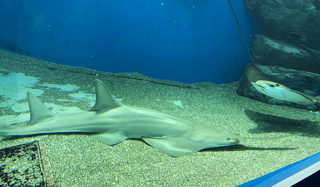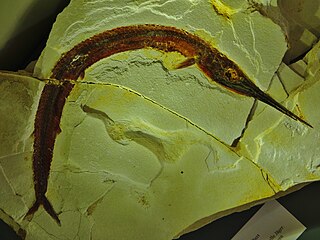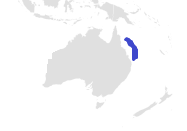| Tanyrhinichthys Temporal range: Kasimovian ~ | |
|---|---|
| Scientific classification | |
| Kingdom: | |
| Phylum: | |
| Class: | |
| Family: | |
| Genus: | †Tanyrhinichthys Gottfried, 1987 |
| Binomial name | |
| †Tanyrhinichthys mcallisteri Gottfried, 1987 | |
Tanyrhinichthys is an extinct genus of prehistoric ray-finned fish with a lengthened rostrum that lived during the Kasimovian (Missourian) age (Upper Pennsylvanian, Upper Carboniferous) in what is now New Mexico, United States. [1] Fossils were recovered from Tinajas Member of the Atrasado Formation (Kinney Brick Quarry). [1]
Tanyrhinichthys had an elongated rostrum equipped with sensory canals, which allowed it to find prey organisms hidden in the substrate, similar to modern sturgeons. It is one of the first actinopterygians to independently evolve an elongate rostrum during the Paleozoic Era, along with Tegeolepis and Phanerorhynchus . [1]

Xenacanthus is a genus of prehistoric xenacanths. Fossils of various species have been found worldwide.

Narcinidae, or numbfishes, are a family of electric rays. They are bottom-dwelling cartilaginous fishes with large, rounded pectoral fin discs and long tails. They can produce an electric discharge for defense, from which their scientific name is derived.
This glossary of ichthyology is a list of definitions of terms and concepts used in ichthyology, the study of fishes.

Platysomus is an extinct genus of ray-finned fish that lived in the Carboniferous and Permian periods. Fossils have been found worldwide.

Aspidorhynchus is an extinct genus of predatory ray-finned fish from the Middle to Late Jurassic. Fossils have been found in Europe, Antarctica and the Caribbean.

The dwarf sawfish or Queensland sawfish, Pristis clavata, is a sawfish of the family Pristidae, found in tropical Australia. This endangered species is the smallest species in its family.

Belonostomus is a genus of prehistoric ray-finned fish that was described by Louis Agassiz in 1844. It is a member of the order Aspidorhynchiformes, a group of fish known for their distinctive elongated rostrums. The oldest known species are from the Upper Jurassic of Germany, with the youngest known species from the late Paleocene. Fossils of Belonostmus have been found worldwide in marine deposits. It likely consumed plankton or other small fish.

Members of the family Narkidae are commonly known as sleeper rays. They are restricted to the temperate and tropical Indo-West Pacific from South Africa to Japan to Indonesia, and are exclusively marine and are absent from freshwater habitats. They occur from the intertidal zone to the continental shelf and the upper continental slope to a depth of 350 meters, favoring soft-bottomed habitats.

The tropical sawshark, Pristiophorus delicatus, is a recently described species of sawshark, family Pristiophoridae, formerly known in literature as Pristiophorus sp. B. It is endemic to northeastern Australia, found on the upper continental slope off Queensland from south of the Samaurez Reef, at a depth of 246–405 meters (807–1,329 ft). Its specific epithet delicatus is Latin for "delicate", referring to the fine teeth on its saw-like rostrum.

Australosomus is an extinct genus of prehistoric ray-finned fish that lived during the Early Triassic epoch in what is now Greenland, Kenya, Tanzania, Madagascar, South Africa and Canada.
Haplolepis is an extinct genus of prehistoric ray-finned fish that lived during the late Moscovian stage of the Pennsylvanian epoch.
Synaptotylus is an extinct genus of prehistoric sarcopterygians or lobe-finned fish from the Pennsylvanian. The type species is Synaptotylus newelli.
Coccocephalichthys is an extinct genus of prehistoric bony fish from the Carboniferous period. The type species, C. wildi, lived during the Bashkirian age of the Pennsylvanian epoch in what is now Lancashire, United Kingdom.
Cylindracanthus is an extinct genus of Cretaceous to Eocene aged ray-finned fish. It is almost exclusively known from bony rostrum fragments as well as some associated teeth, with the rest of the skeleton being cartilaginous. While originally considered to be closely related to billfish, the structure of its rostrum is dissimilar, and is unlikely to be closely related, some later studies suggested closer affinities to the Acipenseriformes. However, this was later rejected due to the lack of osteocytes in histologically examined specimens, which resembles the condition of derived teleosts. A close relation to Blochius has been suggested.
Guntherichthys is an extinct genus of prehistoric bony fish that lived during the late Mississippian/early Pennsylvanian in what is now Utah, United States. Fossils were recovered from the Manning Canyon Shale. The genus is named after Lloyd Gunther.
Spinofacia is an extinct genus of prehistoric bony fish that lived during the late Mississippian/early Pennsylvanian in what is now Utah, United States. Fossils were recovered from the Manning Canyon Shale.

The red gurnard, also known as the East Atlantic red gurnard or soldier, is a benthic species of ray-finned fish belonging to the family Triglidae, the gurnards and sea robins. This fish is found in the eastern Atlantic Ocean, including the Mediterranean Sea and the Black Sea.
Chuhsiungichthys is an extinct genus of ichthyodectiform ray-finned fish that lived in freshwater environments in what is now Yunnan, China, and Kyushu, Japan, during the Cretaceous. It differs from its sister genus, Mesoclupea, primarily by having a comparatively more anteriorly-placed dorsal fin.

Pterygotrigla arabica is a species of ray-finned fish belonging to the family Triglidae, the gurnards and sea robins. This fish is found in the northern Indian Ocean.

Yelangichthys is an extinct genus of prehistoric bony fish that lived during the Anisian age of the Middle Triassic epoch in what is now Guizhou, China. The type and only species, Y. macrocephalus, is known from two specimens, both of which were recovered from the Upper Member of the Guanling Formation.